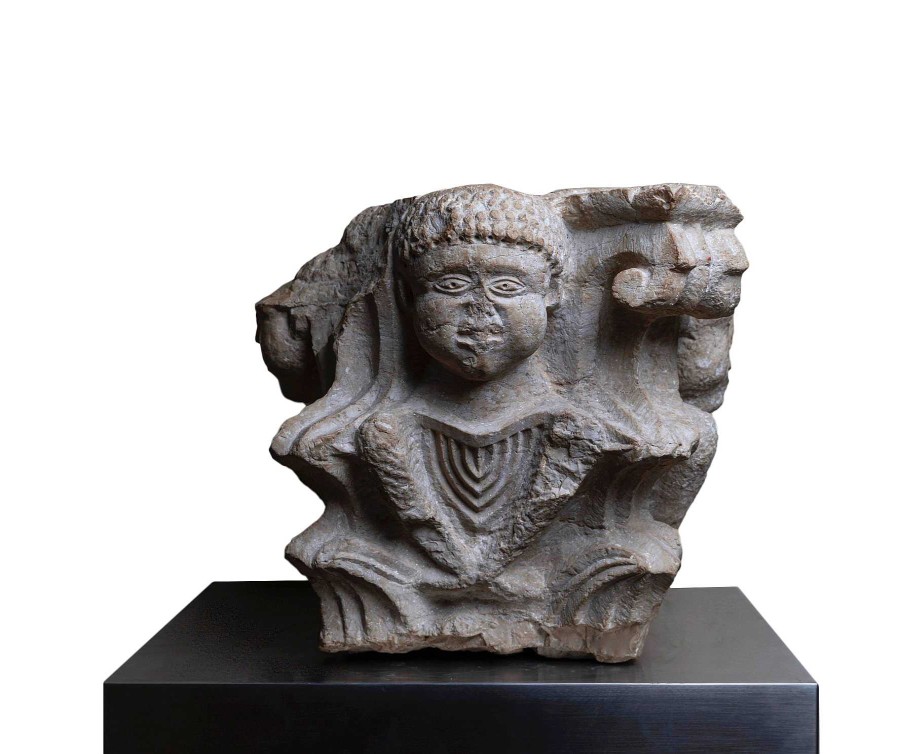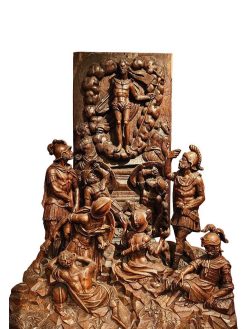Moyen Age | Dei Bardi Art Chapiteau Roman Representant Quatre Africains – Pouilles, Xiiie Siecle
€13,020.00 €91.49
Moyen Age | Dei Bardi Art Chapiteau Roman Representant Quatre Africains – Pouilles, Xiiie Siecle

Chapiteau Roman Représentant Quatre Africains – Pouilles, Xiiie Siècle
Large Stone Capital Carved On Each Side In Strong Relief. The Basket Is Covered With Two Crowns Of Vertical Acanthus Leaves Which Sprout From The Astragal And Fill The Space Between The Human Heads Which Decorates Each Side; Each Angle Is Underlined By A Volute Which Accentuates The Square Format. The Motif Of Heads Emerging From Foliage Follows A Well-Established Late Roman Tradition, Of Which Examples Are Still Found In Apulia.
The Four Heads, Carved In High Relief, Have Facial Features That Identify Them As Black Africans : They Have Full Lips, Wide Noses And The Tightly Curled Hair Covers Only The Upper Part Of Their Ears; They Have Closely Set Eyes, With Convex Eyeballs.
The Creator Of The Capital Actually Knew Black People: The Difference In Hairstyle, One With Braided Hair, The Other With Hair In Small Curls Is A Particularly Naturalistic Touch Which Falls Outside The Limits Of The Accepted Medieval Stereotype Of Black Africans.
One Of The Important Achievement Of Visual …
Lire La Suite
… Art In The West During Medieval Period Was The Rediscovery Of An Effective Means Of Depicting Human Racial Variation.
There Was In Apulia Ample Opportunity For The Study Of The Appearance Of African Saracens And In The Late 12Th Century Positive Images Of Black Africans Began To Increase. This Phenomenon Was Encouraged By A Developing Interest In Blacks On The Part Of The Hohenstaufen Emperors Henry Vi And Frederick Ii. Henry’S Conquest Of Sicily In The 1190S Brought A Number Of Black Moslems Under His Rule, And Miniatures From The Period Record This Fact. Also, The Court Of Frederick Ii Of Hohenstaufen (1194–1250), A Center Of Intellectual Exchange In His Time, Shows Black Africans In An Array Of Positions That Would Later Recur In Renaissance And Baroque Court Culture. In The 1220S Frederick, The German King, Roman Emperor (From 1220), And Successor Of The Norman Kings In Sicily, Established An Islamic Colony Which Included A Number Of Blacks At Lucera In Apulia, And At Least Three Sculptures Can Be Associated With These Africans. One Is A Capital From Troia Depicting A Remarkably Naturalistic Black As Well As Other Varied Ethnic Types. The Second Is The Four-Headed Capital At The Metropolitan Museum Of Art. The Third Work Is A Portrait Of Johannes Maurus, A Black Who Was Frederick’S Chamberlain. Those Sculptures Signify More Than A Record Of The Black Presence In Southern Italy At This Time. The Representation Of Africans Was New To The Art Of Apulia And Even After The Fall Of The Hohenstaufen, Artists Made Repeated References To The Family’S Fondness For Black People In Art And In Life. The Two Blacks Who Appear In The Adoration Of The Magi On Nicola Pisano’S Siena Pulpit Are Undoubtedly Based On African Retainers At The Hohenstaufen Court.
Clearly Our Capital And The One At The Metropolitan Museum Of Art As Well As The Capital From Troia Are Associated By Subject Matter And, To A Degree, By Style. The Unusual Iconography Suggest That Our Capital Is The Product Of A Very Peculiar Cultural Back Ground Which Can Be Found In The Cosmopolitan Atmosphere Of 13Th Century South Of Italy.
Related Literature :
David Abulafia, Frederick Ii: A Medieval Emperor,Oxford University Press, 1988
Henri Bresc, « Frédéric Ii Et L’Islam », Dans Anne-Marie Flambard Héricher (Dir.), Frédéric Ii (1194-1250) Et L’Héritage Normand De Sicile, Caen : Presses Universitaires De Caen, 2001
Sam Fogg, Architecture & Ornament, 22 October – 19 November 2020, London
Sylvain Gouguenheim, Frédéric Ii, Un Empereur De Légende, Paris, Perrin, 2015
Paul H. D. Kaplan. “Black Africans In Hohenstaufen Iconography.” Gesta, Vol. 26, No. 1, [University Of Chicago Press, International Center Of Medieval Art], 1987, Pp. 29–36
Ostoia Vera K. ‘To Represent What Is As It Is.’” The Metropolitan Museum Of Art Bulletin, Vol. 23, No. 10, The Metropolitan Museum Of Art, 1965, Pp. 367–72
Dorothea Weltecke, « Emperor Frederick Ii, « Sultan Of Lucera », « Friend Of The Muslims », Promoter Of Cultural Transfer : Controversies And Suggestions », Dans Jorg Feuchter (Dir.), Cultural Transfers In Dispute: Representations In Asia, Europe And The Arab World Since The Middle Ages, Chicago, University Of Chicago Press, 2011

































Reviews
There are no reviews yet.